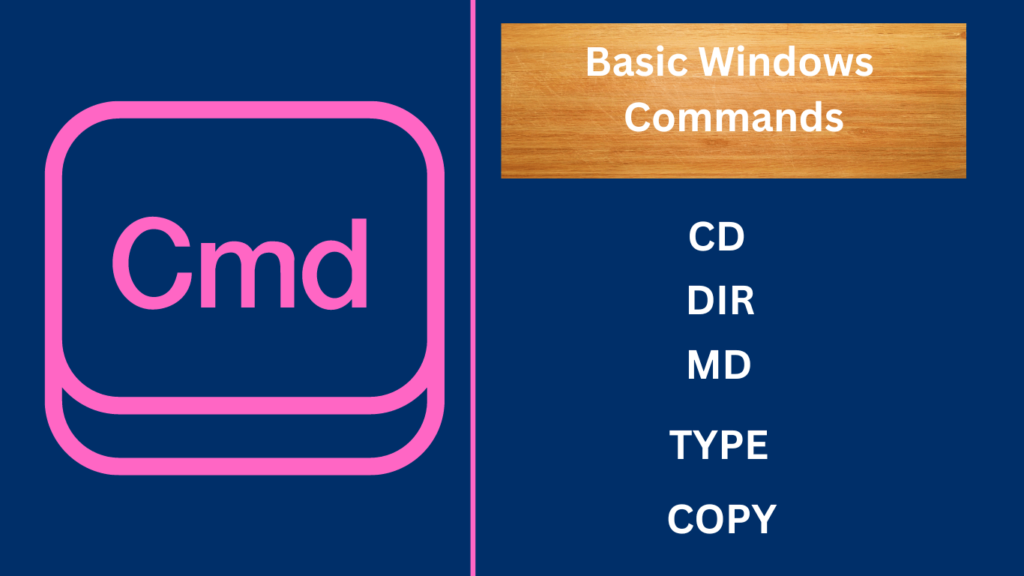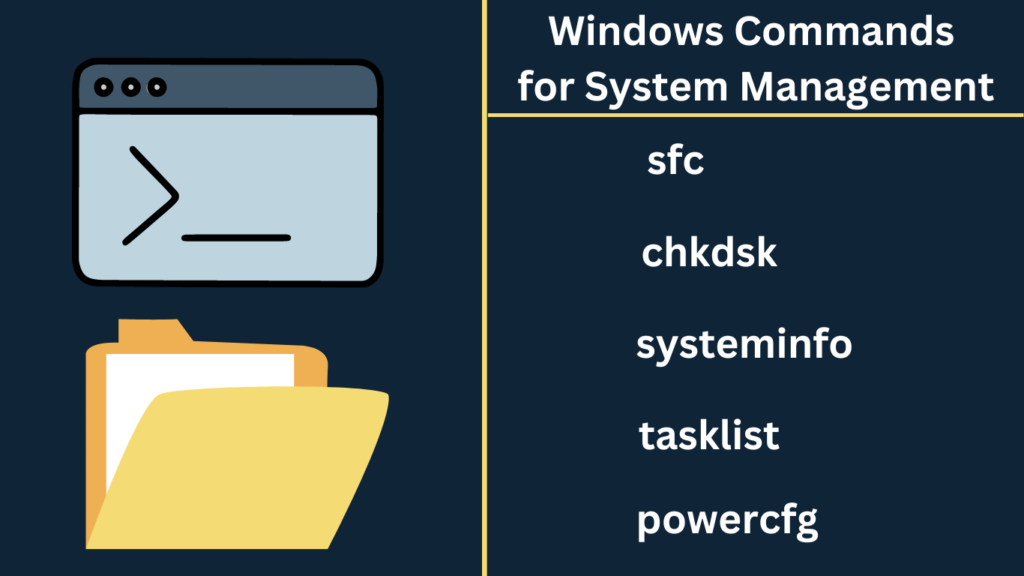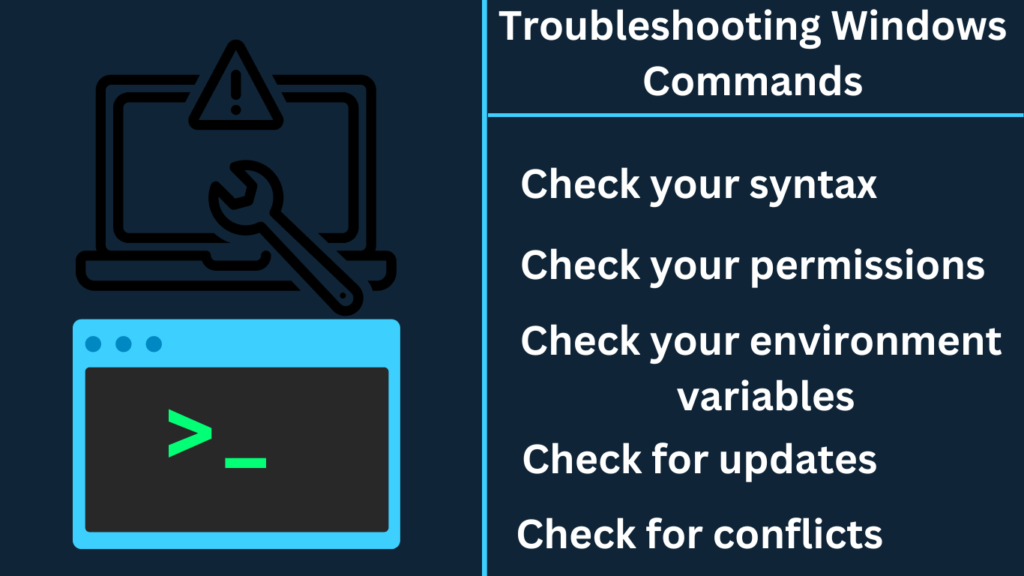Hey do you want to know Windows Commands list, Basic Windows Commands, Advanced Windows Commands, Windows Command Prompt Shortcuts, Windows PowerShell Commands.
Also, Windows Commands for File Management, Windows Commands for Networking, Windows Commands for System Management, Troubleshooting Windows Commands, Windows Commands Cheat Sheet, then follow this article.

As a frequent user of Windows, you may be familiar with the graphical user interface (GUI) of the operating system. However, the command-line interface (CLI) can be a powerful tool for boosting your productivity.
Windows commands give you access to a wide range of functionality and can help you perform tasks more efficiently. In this comprehensive guide, I will take you through everything you need to know about mastering Windows commands.
Introduction to Windows Commands
Windows commands are a set of instructions that can be executed in the CLI. They are a way of interacting with the operating system without using the GUI. Windows commands are executed in the Command Prompt or Windows PowerShell.
The Command Prompt is a basic CLI that allows you to execute simple commands. Windows PowerShell, on the other hand, is a more advanced CLI that allows you to execute complex scripts and manage the Windows operating system.
Windows commands are a powerful tool for boosting your productivity. They can help you automate tasks, troubleshoot problems and perform complex operations quickly and efficiently.
Basic Windows Commands for Productivity
If you are new to using Windows commands, there are some basic commands that you should know. These commands are simple to execute and can help you perform tasks quickly and efficiently.

cd – This command allows you to change the current directory.
For example, if you want to change to the C: drive, you can execute the command “cd C:\”.
dir – This command lists the contents of the current directory. You can use it to view files and folders in a directory.
md – This command creates a new directory. For example, if you want to create a new directory called “My Documents”, you can execute the command “md My Documents”.
type – This command allows you to view the contents of a file. For example, if you want to view the contents of a file called “example.txt”, you can execute the command “type example.txt”.
copy – This command allows you to copy a file from one location to another. For example, if you want to copy a file called “example.txt” from the C: drive to the D: drive, you can execute the command “copy C:\example.txt D:\”.
These basic commands are just the tip of the iceberg when it comes to Windows commands. They are a great starting point for learning how to use the CLI and can help you perform tasks more efficiently.
Advanced Windows Commands for Productivity
Once you have mastered the basic Windows commands, you can move on to more advanced commands. These commands are more complex and can help you perform more advanced tasks.

netstat – This command allows you to view the network connections on your computer. It can help you troubleshoot network problems and identify potential security issues.
tasklist – This command allows you to view the list of running processes on your computer. It can help you identify resource-intensive processes and troubleshoot performance issues.
ping – This command allows you to test the connectivity between your computer and another device on the network. It can help you troubleshoot network connectivity issues.
sfc – This command allows you to scan and repair system files on your computer. It can help you troubleshoot problems with the operating system.
ipconfig – This command allows you to view the IP configuration for your computer. It can help you troubleshoot network connectivity issues and identify potential security issues.
Advanced Windows commands can be a powerful tool for boosting your productivity. They can help you troubleshoot problems and perform complex tasks quickly and efficiently.
Windows Command Prompt Shortcuts
In addition to Windows commands, there are also Command Prompt shortcuts that can help you work more efficiently. These shortcuts can help you navigate the CLI more quickly and easily.
Tab – This shortcut allows you to auto-complete commands and file names. Simply type the first few letters of a command or file name and press Tab to auto-complete.
Ctrl+C – This shortcut allows you to stop a command that is currently executing. It can be useful if a command is taking too long to execute or if you need to cancel a command.
Ctrl+V – This shortcut allows you to paste text into the Command Prompt. It can be useful if you need to enter a long command or if you want to save time by copying and pasting commands.
Ctrl+A – This shortcut allows you to select all text in the Command Prompt. It can be useful if you need to copy or delete all text in the Command Prompt.
Up/Down arrow keys – These shortcuts allow you to navigate through previously executed commands. It can be useful if you need to re-execute a command or if you want to modify a previously executed command.
Windows Command Prompt shortcuts can help you work more efficiently and save time.
Windows PowerShell Commands for Productivity
In addition to the Command Prompt, Windows PowerShell is another CLI that can help you boost your productivity. PowerShell is a more advanced CLI that allows you to execute complex scripts and manage the Windows operating system.
Get-Process – This command allows you to view the list of running processes on your computer. It can help you identify resource-intensive processes and troubleshoot performance issues.
Get-ChildItem – This command allows you to view the contents of a directory. It can help you navigate through files and folders quickly and efficiently.
Set-ExecutionPolicy – This command allows you to change the execution policy for scripts on your computer. It can help you manage script execution and prevent potential security issues.
Get-EventLog – This command allows you to view the Windows event logs on your computer. It can help you troubleshoot system errors and identify potential security issues.
New-Item – This command allows you to create a new item, such as a file or directory. It can help you automate tasks and perform complex operations quickly and efficiently.
Windows PowerShell commands can be a powerful tool for managing the Windows operating system and automating tasks.
Windows Commands for File Management
One of the most common tasks that users perform on their computer is file management. Windows commands can help you manage files and folders quickly and efficiently.

xcopy – This command allows you to copy files and directories. It can help you perform backups and transfer files between locations.
move – This command allows you to move files and directories. It can help you reorganize your files and folders and free up disk space.
attrib – This command allows you to view and modify file attributes. It can help you hide files and folders or make them read-only.
del – This command allows you to delete files and directories. It can help you free up disk space and remove unwanted files.
ren – This command allows you to rename files and directories. It can help you organize your files and folders and make them easier to find.
Windows commands for file management can help you manage your files and folders more efficiently and effectively.
Windows Commands for Networking
If you are a network administrator or need to troubleshoot network issues, Windows commands can be a powerful tool for managing your network.

ipconfig – This command allows you to view the IP configuration for your computer. It can help you troubleshoot network connectivity issues and identify potential security issues.
ping – This command allows you to test the connectivity between your computer and another device on the network. It can help you troubleshoot network connectivity issues.
netstat – This command allows you to view the network connections on your computer. It can help you troubleshoot network problems and identify potential security issues.
tracert – This command allows you to trace the route that packets take between your computer and another device on the network. It can help you identify network connectivity issues.
nslookup – This command allows you to query DNS servers to resolve hostnames to IP addresses. It can help you troubleshoot DNS issues and identify potential security issues.
Windows commands for networking can help you manage your network more efficiently and troubleshoot network issues quickly and effectively.
Windows Commands for System Management
Windows commands can also be a powerful tool for managing the Windows operating system. They can help you troubleshoot system errors and perform complex operations quickly and efficiently.

sfc – This command allows you to scan and repair system files on your computer. It can help you troubleshoot problems with the operating system.
chkdsk – This command allows you to check the file system and disk for errors. It can help you troubleshoot disk errors and prevent potential data loss.
systeminfo – This command allows you to view system information for your computer. It can help you troubleshoot system errors and identify potential security issues.
tasklist – This command allows you to view the list of running processes on your computer. It can help you identify resource-intensive processes and troubleshoot performance issues.
powercfg – This command allows you to manage power settings on your computer. It can help you optimize power settings and extend battery life on your laptop.
Windows commands for system management can help you troubleshoot system errors and optimize your computer for better performance.
Troubleshooting Windows Commands
While Windows commands can be a powerful tool for boosting your productivity, there may be times when you encounter issues with executing commands. Here are some troubleshooting tips to help you resolve any issues you may encounter.

Check your syntax – Make sure that you have entered the command correctly. Even a small typo can cause a command to fail.
Check your permissions – Some commands may require administrator permissions to execute. Make sure that you are logged in as an administrator or have the required permissions.
Check your environment variables – Some commands may rely on environment variables to execute. Make sure that your environment variables are set up correctly.
Check for updates – Some commands may require updates to the operating system or other software. Make sure that your operating system and software are up to date.
Check for conflicts – Some commands may conflict with other software or settings on your computer. Make sure that there are no conflicts that may prevent a command from executing.
By following these troubleshooting tips, you can resolve any issues you may encounter with executing Windows commands and boost your productivity.
Windows Commands Cheat Sheet
To help you get started with Windows commands, here is a cheat sheet that lists some of the most commonly used commands:
cd – Change the current directory
dir – List the contents of a directory
md – Create a new directory
type – View the contents of a file
copy – Copy a file from one location to another
netstat – View network connections
tasklist – View the list of running processes
ping – Test network connectivity
sfc – Scan and repair system files
ipconfig – View the IP configuration
Get-Process – View the list of running processes in PowerShell
Get-ChildItem – View the contents of a directory in PowerShell
xcopy – Copy files and directories
move – Move files and directories
attrib – View and modify file attributes
del – Delete files and directories
ren – Rename files and directories
ipconfig – View the IP configuration
ping – Test network connectivity
netstat – View network connections
tracert – Trace the route that packets take between devices
nslookup – Query DNS servers to resolve hostnames to IP addresses
sfc – Scan and repair system files
chkdsk – Check the file system and disk for errors
systeminfo – View system information
tasklist – View the list of running processes
powercfg – Manage power settings
Conclusion : Windows Commands list
Windows commands can be a powerful tool for boosting your productivity. They can help you automate tasks, troubleshoot problems and perform complex operations quickly and efficiently. By mastering Windows commands, you can become a more efficient and effective user of Windows.
In this comprehensive guide, we have covered everything you need to know about mastering Windows commands. We have covered basic and advanced commands, Command Prompt shortcuts, Windows PowerShell commands, commands for file management, networking, and system management, and troubleshooting tips.
We have also provided a Windows commands cheat sheet to help you get started.By following the tips and tricks in this guide, you will be well on your way to mastering Windows commands and boosting your productivity.

